how to read a book总结(怎样读书精华概要)
- 格式:docx
- 大小:290.81 KB
- 文档页数:3
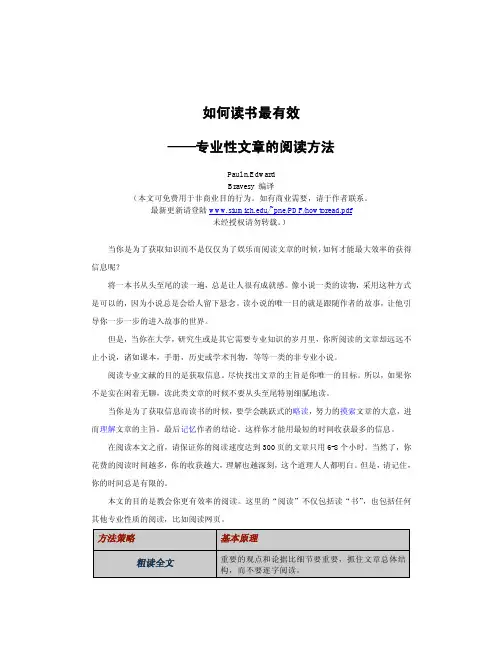
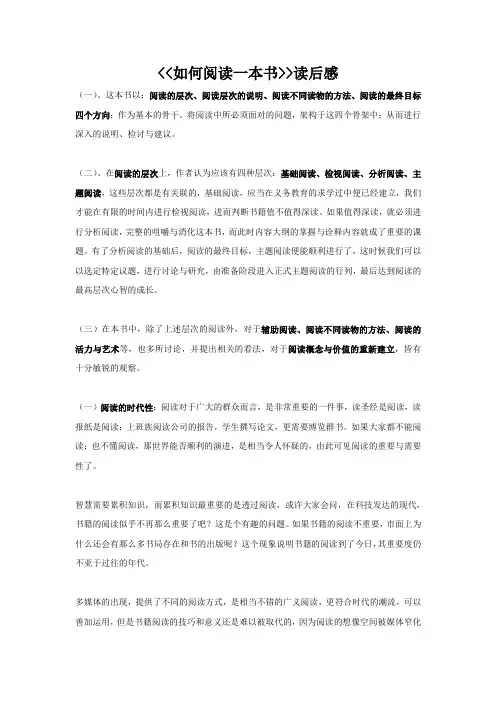
<<如何阅读一本书>>读后感(一)、这本书以:阅读的层次、阅读层次的说明、阅读不同读物的方法、阅读的最终目标四个方向;作为基本的骨干。
将阅读中所必须面对的问题,架构于这四个骨架中;从而进行深入的说明、检讨与建议。
(二)、在阅读的层次上,作者认为应该有四种层次:基础阅读、检视阅读、分析阅读、主题阅读,这些层次都是有关联的,基础阅读,应当在义务教育的求学过中便已经建立,我们才能在有限的时间内进行检视阅读,进而判断书籍值不值得深读。
如果值得深读,就必须进行分析阅读,完整的咀嚼与消化这本书,而此时内容大纲的掌握与诠释内容就成了重要的课题。
有了分析阅读的基础后,阅读的最终目标,主题阅读便能顺利进行了,这时候我们可以以选定特定议题,进行讨论与研究,由准备阶段进入正式主题阅读的行列,最后达到阅读的最高层次心智的成长。
(三)在本书中,除了上述层次的阅读外,对于辅助阅读、阅读不同读物的方法、阅读的活力与艺术等,也多所讨论,并提出相关的看法,对于阅读概念与价值的重新建立,皆有十分敏锐的观察。
(一)阅读的时代性:阅读对于广大的群众而言,是非常重要的一件事,读圣经是阅读,读报纸是阅读;上班族阅读公司的报告,学生撰写论文,更需要博览群书。
如果大家都不能阅读;也不懂阅读,那世界能否顺利的演进,是相当令人怀疑的,由此可见阅读的重要与需要性了。
智慧需要累积知识,而累积知识最重要的是透过阅读,或许大家会问,在科技发达的现代,书籍的阅读似乎不再那么重要了吧?这是个有趣的问题。
如果书籍的阅读不重要,市面上为什么还会有那么多书局存在和书的出版呢?这个现象说明书籍的阅读到了今日,其重要度仍不亚于过往的年代。
多媒体的出现,提供了不同的阅读方式,是相当不错的广义阅读,更符合时代的潮流,可以善加运用,但是书籍阅读的技巧和意义还是难以被取代的,因为阅读的想像空间被媒体窄化了。
《如何阅读一本书》讨论的方向也敏锐的观察到了这一点,骨架深植于技巧与方法中,另人爱不释手,可说是这本书畅销多年的主因之一。
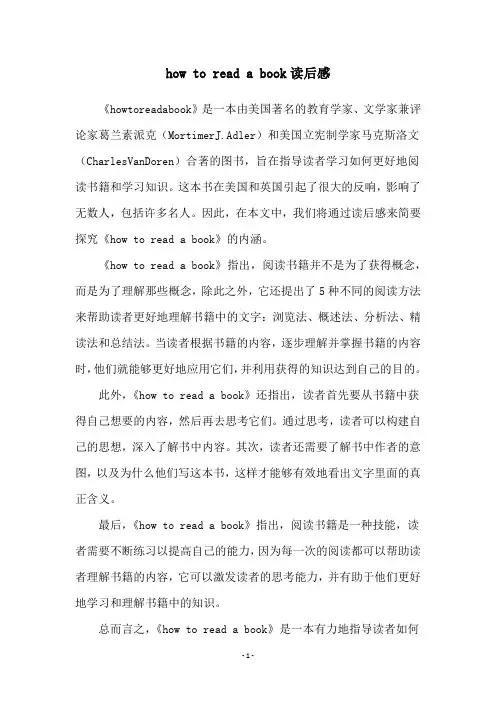
how to read a book读后感《howtoreadabook》是一本由美国著名的教育学家、文学家兼评论家葛兰素派克(MortimerJ.Adler)和美国立宪制学家马克斯洛文(CharlesVanDoren)合著的图书,旨在指导读者学习如何更好地阅读书籍和学习知识。
这本书在美国和英国引起了很大的反响,影响了无数人,包括许多名人。
因此,在本文中,我们将通过读后感来简要探究《how to read a book》的内涵。
《how to read a book》指出,阅读书籍并不是为了获得概念,而是为了理解那些概念,除此之外,它还提出了5种不同的阅读方法来帮助读者更好地理解书籍中的文字:浏览法、概述法、分析法、精读法和总结法。
当读者根据书籍的内容,逐步理解并掌握书籍的内容时,他们就能够更好地应用它们,并利用获得的知识达到自己的目的。
此外,《how to read a book》还指出,读者首先要从书籍中获得自己想要的内容,然后再去思考它们。
通过思考,读者可以构建自己的思想,深入了解书中内容。
其次,读者还需要了解书中作者的意图,以及为什么他们写这本书,这样才能够有效地看出文字里面的真正含义。
最后,《how to read a book》指出,阅读书籍是一种技能,读者需要不断练习以提高自己的能力,因为每一次的阅读都可以帮助读者理解书籍的内容,它可以激发读者的思考能力,并有助于他们更好地学习和理解书籍中的知识。
总而言之,《how to read a book》是一本有力地指导读者如何正确阅读书籍的书籍,提供了5种不同的阅读方法,让读者能够更好地理解书籍中的容,从而更有效地利用书中的知识。
通过不断的努力和阅读练习,读者将能够更好地理解书籍中的文字,从而获得更多的知识。
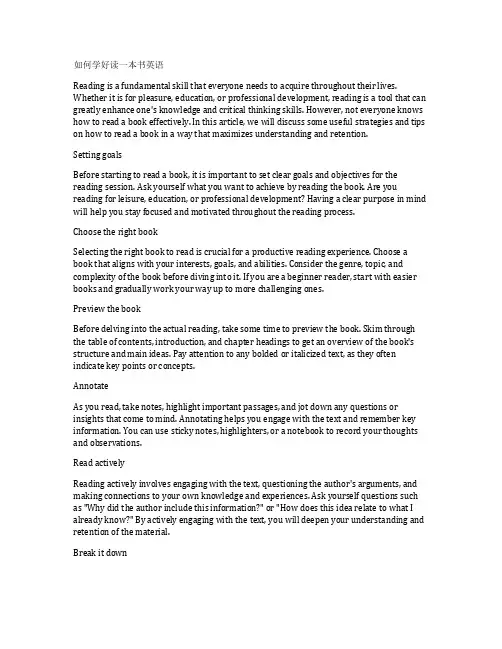
如何学好读一本书英语Reading is a fundamental skill that everyone needs to acquire throughout their lives. Whether it is for pleasure, education, or professional development, reading is a tool that can greatly enhance one's knowledge and critical thinking skills. However, not everyone knows how to read a book effectively. In this article, we will discuss some useful strategies and tips on how to read a book in a way that maximizes understanding and retention.Setting goalsBefore starting to read a book, it is important to set clear goals and objectives for the reading session. Ask yourself what you want to achieve by reading the book. Are you reading for leisure, education, or professional development? Having a clear purpose in mind will help you stay focused and motivated throughout the reading process.Choose the right bookSelecting the right book to read is crucial for a productive reading experience. Choose a book that aligns with your interests, goals, and abilities. Consider the genre, topic, and complexity of the book before diving into it. If you are a beginner reader, start with easier books and gradually work your way up to more challenging ones.Preview the bookBefore delving into the actual reading, take some time to preview the book. Skim through the table of contents, introduction, and chapter headings to get an overview of the book's structure and main ideas. Pay attention to any bolded or italicized text, as they often indicate key points or concepts.AnnotateAs you read, take notes, highlight important passages, and jot down any questions or insights that come to mind. Annotating helps you engage with the text and remember key information. You can use sticky notes, highlighters, or a notebook to record your thoughts and observations.Read activelyReading actively involves engaging with the text, questioning the author's arguments, and making connections to your own knowledge and experiences. Ask yourself questions such as "Why did the author include this information?" or "How does this idea relate to what I already know?" By actively engaging with the text, you will deepen your understanding and retention of the material.Break it downIf you are reading a lengthy or complex book, break it down into smaller sections or chapters. Set aside time each day to read a manageable portion of the book, rather than trying to read it all at once. This approach will help you stay focused, prevent burnout, and retain more information.SummarizeAfter finishing a section or chapter, take a few minutes to summarize the main points and ideas. Summarizing helps reinforce your understanding of the material and identifies any gaps in your knowledge. You can write a brief summary, create a mind map, or discuss the content with a friend or colleague.Dialogue with the textEngage in a dialogue with the text by questioning the author's arguments, reflecting on your own beliefs and values, and considering alternative viewpoints. Challenge the text, but also be open to new ideas and perspectives. By actively engaging with the author's ideas, you will develop critical thinking skills and deepen your understanding of the material.ReflectAfter finishing the book, take some time to reflect on what you have read. Consider how the book has influenced your thinking, values, or behavior. Reflect on any new insights or perspectives gained from the book and think about how you can apply them to your own life or work.In conclusion, reading a book effectively requires setting goals, choosing the right book, previewing the content, annotating, reading actively, breaking it down, summarizing, dialoguing with the text, and reflecting on the material. By following these strategies and tips, you can improve your reading skills, deepen your understanding of the material, and enhance your critical thinking abilities. Happy reading!。
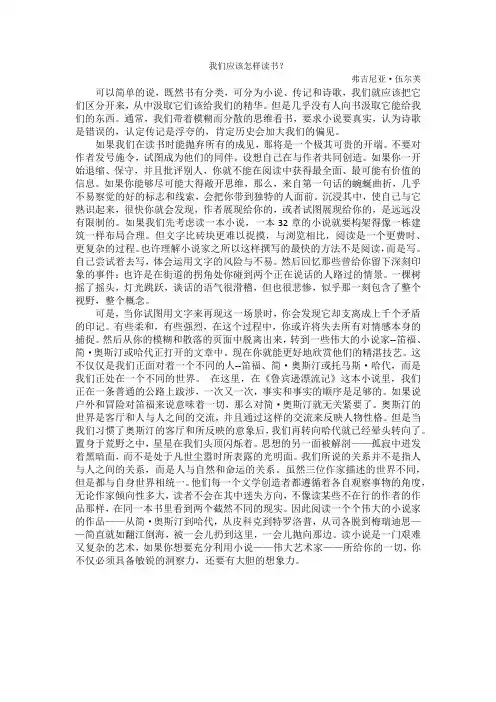
我们应该怎样读书?弗吉尼亚·伍尔芙可以简单的说,既然书有分类,可分为小说、传记和诗歌,我们就应该把它们区分开来,从中汲取它们该给我们的精华。
但是几乎没有人向书汲取它能给我们的东西。
通常,我们带着模糊而分散的思维看书,要求小说要真实,认为诗歌是错误的,认定传记是浮夸的,肯定历史会加大我们的偏见。
如果我们在读书时能抛弃所有的成见,那将是一个极其可贵的开端。
不要对作者发号施令,试图成为他们的同伴。
设想自己在与作者共同创造。
如果你一开始退缩、保守,并且批评别人,你就不能在阅读中获得最全面、最可能有价值的信息。
如果你能够尽可能大得敞开思维,那么,来自第一句话的蜿蜒曲折,几乎不易察觉的好的标志和线索,会把你带到独特的人面前。
沉浸其中,使自己与它熟识起来,很快你就会发现,作者展现给你的,或者试图展现给你的,是远远没有限制的。
如果我们先考虑读一本小说,一本32章的小说就要构架得像一栋建筑一样布局合理。
但文字比砖块更难以捉摸,与浏览相比,阅读是一个更费时、更复杂的过程。
也许理解小说家之所以这样撰写的最快的方法不是阅读,而是写。
自己尝试着去写,体会运用文字的风险与不易。
然后回忆那些曾给你留下深刻印象的事件:也许是在街道的拐角处你碰到两个正在说话的人路过的情景。
一棵树摇了摇头,灯光跳跃,谈话的语气很滑稽,但也很悲惨,似乎那一刻包含了整个视野,整个概念。
可是,当你试图用文字来再现这一场景时,你会发现它却支离成上千个矛盾的印记。
有些柔和,有些强烈,在这个过程中,你或许将失去所有对情感本身的捕捉。
然后从你的模糊和散落的页面中脱离出来,转到一些伟大的小说家--笛福、简·奥斯汀或哈代正打开的文章中。
现在你就能更好地欣赏他们的精湛技艺。
这不仅仅是我们正面对着一个不同的人--笛福、简·奥斯汀或托马斯·哈代,而是我们正处在一个不同的世界。
在这里,在《鲁宾逊漂流记》这本小说里,我们正在一条普通的公路上跋涉,一次又一次,事实和事实的顺序是足够的。
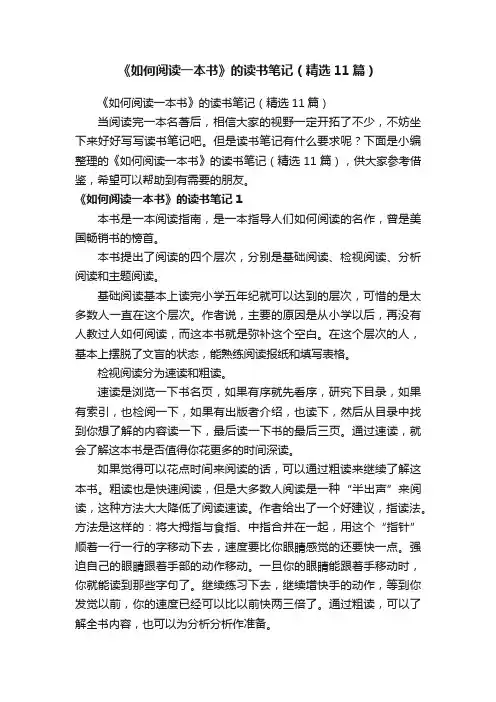
《如何阅读一本书》的读书笔记(精选11篇)《如何阅读一本书》的读书笔记(精选11篇)当阅读完一本名著后,相信大家的视野一定开拓了不少,不妨坐下来好好写写读书笔记吧。
但是读书笔记有什么要求呢?下面是小编整理的《如何阅读一本书》的读书笔记(精选11篇),供大家参考借鉴,希望可以帮助到有需要的朋友。
《如何阅读一本书》的读书笔记1本书是一本阅读指南,是一本指导人们如何阅读的名作,曾是美国畅销书的榜首。
本书提出了阅读的四个层次,分别是基础阅读、检视阅读、分析阅读和主题阅读。
基础阅读基本上读完小学五年纪就可以达到的层次,可惜的是太多数人一直在这个层次。
作者说,主要的原因是从小学以后,再没有人教过人如何阅读,而这本书就是弥补这个空白。
在这个层次的人,基本上摆脱了文盲的状态,能熟练阅读报纸和填写表格。
检视阅读分为速读和粗读。
速读是浏览一下书名页,如果有序就先看序,研究下目录,如果有索引,也检阅一下,如果有出版者介绍,也读下,然后从目录中找到你想了解的内容读一下,最后读一下书的最后三页。
通过速读,就会了解这本书是否值得你花更多的时间深读。
如果觉得可以花点时间来阅读的话,可以通过粗读来继续了解这本书。
粗读也是快速阅读,但是大多数人阅读是一种“半出声”来阅读,这种方法大大降低了阅读速读。
作者给出了一个好建议,指读法。
方法是这样的:将大拇指与食指、中指合并在一起,用这个“指针”顺着一行一行的字移动下去,速度要比你眼睛感觉的还要快一点。
强迫自己的眼睛跟着手部的动作移动。
一旦你的眼睛能跟着手移动时,你就能读到那些字句了。
继续练习下去,继续增快手的动作,等到你发觉以前,你的速度已经可以比以前快两三倍了。
通过粗读,可以了解全书内容,也可以为分析分析作准备。
分析阅读分为三个阶段。
第一阶段中你要问几个问题,一是你阅读的书是什么类型的书,二是你能不能用一句话来描述整本书说了什么并列出本书的大纲,三是本书的作者想说明或解决什么问题。
第二个阶段其实就是列出细纲。
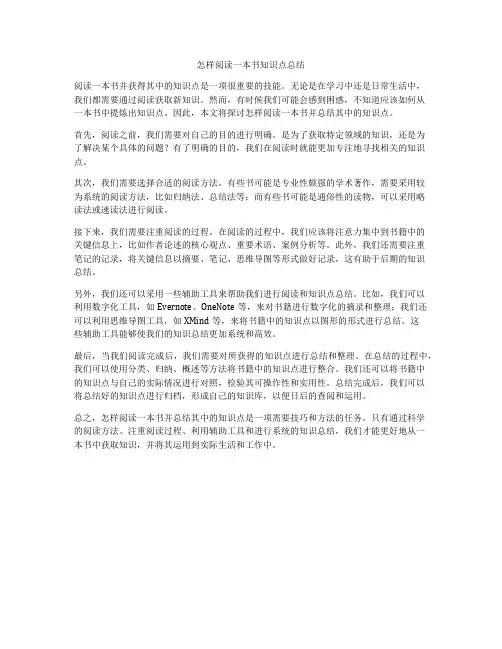
怎样阅读一本书知识点总结阅读一本书并获得其中的知识点是一项很重要的技能。
无论是在学习中还是日常生活中,我们都需要通过阅读获取新知识。
然而,有时候我们可能会感到困惑,不知道应该如何从一本书中提炼出知识点。
因此,本文将探讨怎样阅读一本书并总结其中的知识点。
首先,阅读之前,我们需要对自己的目的进行明确。
是为了获取特定领域的知识,还是为了解决某个具体的问题?有了明确的目的,我们在阅读时就能更加专注地寻找相关的知识点。
其次,我们需要选择合适的阅读方法。
有些书可能是专业性颇强的学术著作,需要采用较为系统的阅读方法,比如归纳法、总结法等;而有些书可能是通俗性的读物,可以采用略读法或速读法进行阅读。
接下来,我们需要注重阅读的过程。
在阅读的过程中,我们应该将注意力集中到书籍中的关键信息上,比如作者论述的核心观点、重要术语、案例分析等。
此外,我们还需要注重笔记的记录,将关键信息以摘要、笔记、思维导图等形式做好记录,这有助于后期的知识总结。
另外,我们还可以采用一些辅助工具来帮助我们进行阅读和知识点总结。
比如,我们可以利用数字化工具,如Evernote、OneNote等,来对书籍进行数字化的摘录和整理;我们还可以利用思维导图工具,如XMind等,来将书籍中的知识点以图形的形式进行总结。
这些辅助工具能够使我们的知识总结更加系统和高效。
最后,当我们阅读完成后,我们需要对所获得的知识点进行总结和整理。
在总结的过程中,我们可以使用分类、归纳、概述等方法将书籍中的知识点进行整合。
我们还可以将书籍中的知识点与自己的实际情况进行对照,检验其可操作性和实用性。
总结完成后,我们可以将总结好的知识点进行归档,形成自己的知识库,以便日后的查阅和运用。
总之,怎样阅读一本书并总结其中的知识点是一项需要技巧和方法的任务。
只有通过科学的阅读方法、注重阅读过程、利用辅助工具和进行系统的知识总结,我们才能更好地从一本书中获取知识,并将其运用到实际生活和工作中。
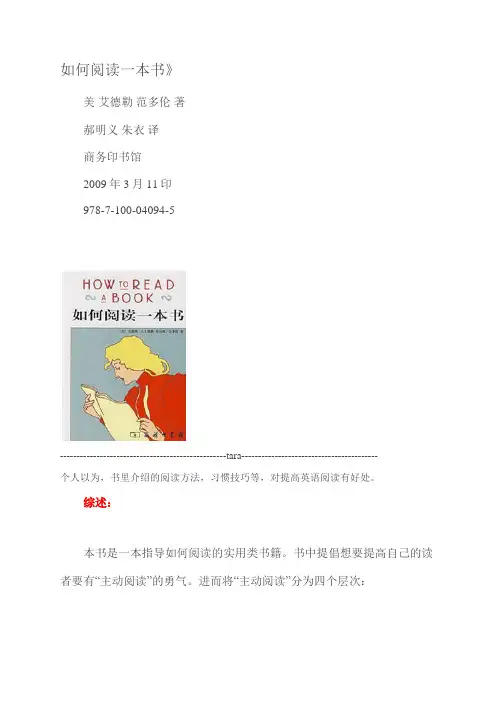
如何阅读一本书》美艾德勒范多伦著郝明义朱衣译商务印书馆2009年3月11印978-7-100-04094-5--------------------------------------------------tara-----------------------------------------个人以为,书里介绍的阅读方法,习惯技巧等,对提高英语阅读有好处。
综述:本书是一本指导如何阅读的实用类书籍。
书中提倡想要提高自己的读者要有“主动阅读”的勇气。
进而将“主动阅读”分为四个层次:1.基础阅读(可忽略)2.检视阅读3.分析阅读4.主题阅读作者在阅读的四个层次和几乎所有的图书类型,纵横两个层面上,探讨了如何进行锻炼心智的主动阅读。
目录:第一篇阅读的层次第四章阅读的第二个层次:检视阅读-----30概念:有系统地略读和粗读:(P31~33)方法:(纲领,关键字阅读tara注)1.先看书名页,然后如果有序就先看序。
要很快地看过去。
特别注意副标题,或其他的相关说明或宗旨,或是作者写作本书的特殊角度。
2.研究目录页,对这本书的基本架构做概括性的理解。
3.如果书中附有索引,也要检阅一下。
根据某一词条被引用的页数的多少(次数),能够判断某个词条的(其)重要性。
这是一种发现核心词和概念的好方法。
4.如果那是本包着书衣的新书,不妨读一下出版者的介绍。
5.从你对一本书的目录很概略,甚至有点模糊的印象当中,开始挑几个看来跟主题息息相关的篇章来看。
如果这些篇章在开头或解围有摘要说明(很多会有),就要仔细地阅读这些说明。
6.最后一步,把书打开来,东翻翻西翻翻,念个一两段,有时候连续读几页,但不要太多。
最重要的是,不要忽略最后的两三页。
很少有作者能拒绝这样的诱惑,而不再结尾几页将自己认为既新又重要的观点重新整理一遍。
在这个层次中,需要注意的问题有:1、阅读的速度:人们可以读得更快,但是对于书籍阅读来说,速度是根据需要而变化的。
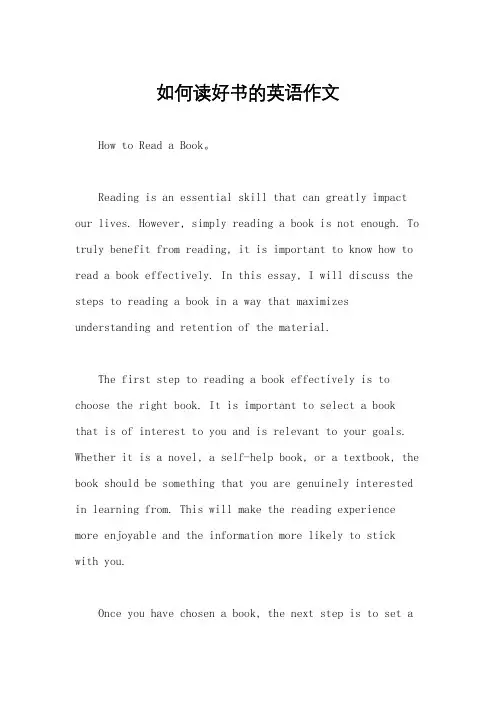
如何读好书的英语作文How to Read a Book。
Reading is an essential skill that can greatly impact our lives. However, simply reading a book is not enough. To truly benefit from reading, it is important to know how to read a book effectively. In this essay, I will discuss the steps to reading a book in a way that maximizes understanding and retention of the material.The first step to reading a book effectively is to choose the right book. It is important to select a bookthat is of interest to you and is relevant to your goals. Whether it is a novel, a self-help book, or a textbook, the book should be something that you are genuinely interested in learning from. This will make the reading experience more enjoyable and the information more likely to stick with you.Once you have chosen a book, the next step is to set apurpose for reading. Are you reading for pleasure, for information, or for a specific goal? Setting a purpose will help you stay focused and engaged while reading. For example, if you are reading a novel for pleasure, your purpose might be to enjoy the story and the writing style. If you are reading a self-help book, your purpose might be to learn and apply the strategies presented in the book.After setting a purpose, it is important to actively engage with the material as you read. This means asking questions, making connections, and taking notes as you go. Asking questions about the material will help you to better understand and remember the content. Making connections between the material and your own experiences or other things you have read will help to deepen your understanding and retention. Taking notes, whether it is writing in the margins of the book or keeping a separate notebook, will help you to organize and remember the key points of the book.In addition to actively engaging with the material, it is important to read with a critical eye. This meansquestioning the author's arguments, evaluating the evidence presented, and considering alternative perspectives. Reading critically will help you to develop a deeper understanding of the material and to form your own opinions about it.Finally, after finishing the book, it is important to reflect on what you have read. Take some time to think about the main ideas, the key points, and how the book has impacted you. Reflecting on the material will help you to solidify your understanding and to apply the knowledge to your own life.In conclusion, reading a book effectively involves choosing the right book, setting a purpose for reading, actively engaging with the material, reading critically, and reflecting on what you have read. By following these steps, you can maximize your understanding and retention of the material, and truly benefit from the books you read.。
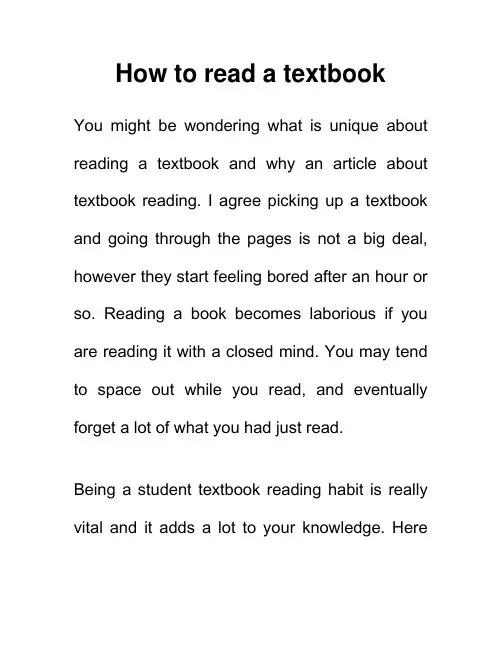
How to read a textbookYou might be wondering what is unique about reading a textbook and why an article about textbook reading. I agree picking up a textbook and going through the pages is not a big deal, however they start feeling bored after an hour or so. Reading a book becomes laborious if you are reading it with a closed mind. You may tend to space out while you read, and eventually forget a lot of what you had just read.Being a student textbook reading habit is really vital and it adds a lot to your knowledge. Hereare the few tips that can make reading an amazing experience.1. Comprehension is the key !!First and the foremost thing that one has to take care is : “Do not focus on speed”. Reading and comprehending a couple of pages is more important than finishing 10 pages without having any context of it. Reading a book with a pre-specified target of finishing a set of pages in a given amount of time is a grave mistake. What is the use of reading a textbook without any idea of the content and the subject. One should focus on the comprehension of the text and increasein the reading speed is just a derivative. You will notice a significant change in the eye span and speed .2. Read to think!!Never read a book to collect just facts and information. Understanding the constructs inside the book is the cornerstone, hence critical thinking is the essence of an effective reading. So the question arises is how to understand the context and theories given in the book?Work breakdown structure ( WBS ) is often used by managers at higher level. One can use thisconcept in reading as well. As the name suggests it is the fragmentation of the work into smaller pieces for a better understanding. If you are can get your fundamental right, erecting a building would not be difficult.Let us take an example to understand the meaning of critical thinking. If you are reading a chapter in mathematics and mugging the equations and formula without thinking , its all useless. You won’t be able to recall the concept a day after or two. We know Sin^2 (X) + Cos^2 (X) =1 , where X is the angle is radians. This is a basic identity from trigonometric that studentslearn at high school level. So what is the best way to remember it? The best way is to make a triangle on the left hand side with sides marked as base, perpendicular and hypotenuse. Now write the equation on the right side of the paper and put the value of sinx and cosx in the identity and you will see it holds true. This way you can understand what trigonometry is all about.3. Only read , understand but do not writeTaking notes while reading is a common thing that we see. Many people advocate about taking notes for a better understanding of the chapter, however it is not the case. Our mind is goodenough to retain things for a short term and that is what we do while taking notes. We just pick the content present in the short term memory and convert it into our notes. We won’t be able to recall the same equation or formula that we wrote an hour earlier.Many people follow this practice of taking notes at the time of reading and thinking. Many students who has this habit of taking notes at the time of reading score less as compared to the students who just read and understand. Hence the best way to understand a subject and retain it for a longer period of time is to writenotes on a paper after finishing the chapter. By inculcating this habit one would be able to revise the chapter easily. If you are not able to recall any concept, just go back and read it again.4. Use Distraction free mode of studyDistractions are all around you in the form of internet, television and people. Hence, do not look around and keep your focus on reading and analysis of the content. Moreover, brain gains focus after some time and its not an instant process. If you take frequent breaks , you won’t be able to stay focused and performance starts to degrade. So taking frequent breaks is verybad, even if the break duration is very small. Ideal study session duration is 40 to 50 minutes, with 10 to 15 minutes breaks in between.5. Recollect the facts at the end of the readingAs soon as you complete the reading , you should go for a short recall. Keep your eyes closed and brain open to rewind the facts, formulas, theories you have read. Since, you have finished reading a moment back, it is easy to take the snapshot of the things you have read. Brain tend to retain the images and snapshots of the things we see and same holds true in the case of reading . Start highlighting importantpoints in the reading, which you can come back to for a quick review. At the end of the wrap up one should go though the notes to recollect important theories and concepts.This article is intended to motivate students for reading. Just follow the basic fundamental of reading and it will be fun to read. You might have seen people engaged in reading for hours and the only reason behind it the habit of reading. They have developed it after many years of focus and concentration. They have books as one of the best mates and this can be true for you as well.。
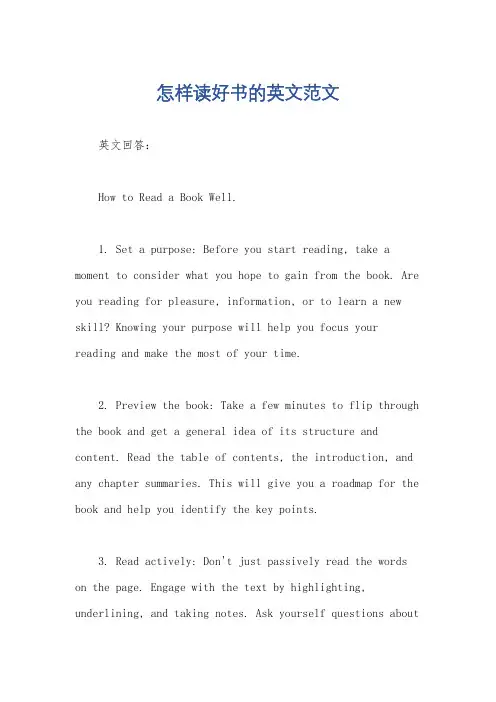
怎样读好书的英文范文英文回答:How to Read a Book Well.1. Set a purpose: Before you start reading, take a moment to consider what you hope to gain from the book. Are you reading for pleasure, information, or to learn a new skill? Knowing your purpose will help you focus your reading and make the most of your time.2. Preview the book: Take a few minutes to flip through the book and get a general idea of its structure and content. Read the table of contents, the introduction, and any chapter summaries. This will give you a roadmap for the book and help you identify the key points.3. Read actively: Don't just passively read the words on the page. Engage with the text by highlighting, underlining, and taking notes. Ask yourself questions aboutwhat you're reading and try to connect it to what you already know.4. Take breaks: It's important to take breaks while you're reading, especially if you're reading for long periods of time. This will help you stay focused and avoid burnout.5. Reflect on what you've read: After you finish reading a section, take a moment to reflect on what you've learned. Summarize the key points, identify any questions you have, and consider how the information applies to your life.6. Discuss the book with others: One of the best ways to improve your understanding of a book is to discuss it with others. Join a book club, talk to friends or family members about what you're reading, or post your thoughts online.7. Practice: The more you read, the better you'll become at it. Make reading a regular part of your routineand challenge yourself to read different types of books.The more you practice, the more you'll enjoy the processand the more you'll learn.中文回答:如何高效阅读。
【004】如何读好一本书HowtoReadaBook(I)前言多久没有读过书了小学的时候,我们就知道,书籍是人类进步的阶梯,但随着互联网的发展,碎片化阅读的泛滥,无数人每天获取的资讯内容大部分来自微信公众号和朋友圈,还有多少人还会去捧起一本书(或者电子书)来仔细阅读了?书知道答案生活当中,我们常常遇到很多问题,有的人就直接逃避,忽略;有的人就自己默默地吞咽问题自己埋头思考;还有的人遇到问题就直接去问,比如问搜索引擎,问好友,问父母,但很可惜的是,很多问题,他们也不知道。
但实际上,很多可能无解的问题,早已被各种先贤智者们思考过了,还把答案系统全面地总结在书本里面,所以,书中自有黄金屋,书中自有颜如玉,书知道答案。
没有时间阅读为什么买书的时候总是买买买,但是书堆积在角落上都积灰了,都长毛了还没有读完?那么,这篇文章可以学会如何提升读书效率并在计划的时间内把书读完。
读书转化率太低为什么有的人读了一本书能够说出很多思考和见解?有的人读完一本书却感觉脑袋空空?甚至连主要的观点都列举不出来?为什么大师们列的书单似乎都差不多,有的人读了就变成了牛人,有的人读了却依然”过不好这一生“?这些问题都是读书转化率太低造成的,一本书,如何读懂,读透,化作自己的的思想和内涵,并且在实际生活中去践行,去应用,去解决问题? How to read a book 就是这样一篇,能够帮你解决如何读懂一本书,如何内化一本书,如何用好一本书的文章。
原文是英文版,建议有四级基础的人直接读原文罢,就不需要等我的翻译了,原文表达更加精确和内涵丰富。
而要是想要看到中文版的同学,且听在下慢慢道来。
How to Read a Book原作者:Paul N.EdwardsSchool of InformationUniversity of Michigan 英文版原文下载链接:/PDF/howtoread.pdf 当你在为信息或者学习而阅读的时候,当你不是在为阅读快感而阅读的时候,怎样才能从一本书(或者任何一篇文章)里面学到最多?从开头第一个字一直读到结尾的最后一个字是非常舒服的,有一些书,比如小说,必须按照这种方式来阅读,因为一部精彩的小说最基本的要做到的是能完全吸引住读者的注意力。
how to read a book读书笔记
阅读一本书并撰写读书笔记是提高理解力、深化思考的重要方式。
以下是一个关于如何读一本书并撰写读书笔记的简要指南:
阅读书籍:
预览:在深入阅读之前,先快速翻阅目录、封面、前言等,获取整体了解。
设定目标:确定阅读的目标,是为了获取信息、学习知识,还是进行文学欣赏或批判性思考?
主动阅读:阅读时要保持主动,提问自己,思考作者的意图,逐步建立自己的理解框架。
标记和注释:使用标记、划线和注释来强调重要信息、关键概念或自己的思考。
这有助于后期回顾和整理。
注意上下文:关注段落之间的联系,理解上下文对于理解整体意义至关重要。
做笔记:在阅读的过程中,随时记录关键点、想法、问题,方便后期回顾。
读书笔记:
记录关键信息:重点关注书中的关键概念、主题、论点等,确保读书笔记包含了重要的信息。
个人反应:不仅记录书中的内容,还可以加入个人的思考、观点和感受。
这有助于理解信息的个人化。
整理结构:将笔记整理成有条理的结构,可以采用大纲、图表或其他形式,以便更好地理解和回顾。
提出问题:在笔记中提出问题,这有助于激发思考、深化理解,并为未来的学习提供方向。
总结:在笔记的结尾,进行一次总结,简洁概括书中的主要观点和你的理解。
后续计划:根据读书笔记,制定后续的学习计划,可能包括进一步阅读相关材料、深化理解或进行讨论。
记住,读书笔记是为了帮助你更好地理解和记忆所读的内容,因此,制定适合自己阅读习惯和学习目标的方法是非常重要的。
读《任何阅读一本书HOWTOREADABOOK》之读书笔记1 书本框架:λ主动阅读的优势,所有的求知都带有主动性λ阅读的四个阶段:基础阅读、概要阅读、分析阅读、主题阅读λ每个一个阶段都要分为几个小阶段λ本书的重要部分:分析阅读λ本书的主要目标:为增进理解力而阅读,达成主题阅读的目的2 本书诠释的意图:1.基础阅读:分为四个小阶段:1、学习阅读的准备工作,包括身体智力方面(准备);2、孩子会学习读一些简单的读物(认字);3、快速建立字汇的能力(简单读写能力);4、精炼与增进前面所学的技巧(“成熟”阅读能力)2.概要阅读:3.(一) 分为两种:包括:有系统的略读或者粗读(浏览,如书名、书目等等);粗浅的阅读(读书)4.A. 有系统的略读或者粗读:1、书名,可以做个简单的分类;2、目录,了解本书大纲;3、索引,可以评估本书涵盖了那些议题的范围,或者评估本书的价值;4、出版者介绍,了解本书的主旨;5、挑几个与主题相关的章节看看,了解细节;6、随便翻开几页连续读读(结尾的重要性,一般结尾都会有总结,有助于你了解本书)5.B. 粗浅的阅读:最主要的:头一次面对一本难读的一本书的时候,从头到尾先读完一遍,碰到不懂得不要停下来查询或者思索。
----很难做到呀!这样可以为分析阅读做好心理准备。
就算没有第二遍阅读,那么第一遍你了解50%,总比不了解得强-----一定要先读一遍。
6.C. 如何解决逗留和倒退,手指是最好得工具+主动7.(二) 优势:为分析阅读作准备;作为主题阅读的重要角色8.3) 分析阅读:9.分析阅读第一阶段:掌握大纲10.(一) 给一本书分类,分实用性和理论性。
11.(二) 透视一本书:书的大纲框架:书的主题,书的细节如何构成本书框架;如何给一本书拟框架,这样更能了解一本书的框架(包括整体大纲、各部分大纲、重点部分大纲等等)12.(三) 发现作者的意图:找出作者的问的问题,或者说想要解决的问题13.(四) 第一阶段规则:14. 1 规则一:在阅读一本书之前一定要知道你阅读的是哪一种类型的书(给书分类)15. 2 规则二:使用一个单一句子或者几句话来叙述整本书的内容(透视一本书-主题)16. 3 规则三:将书中重要篇章列举出来,说明他们如何按照顺序组成一个整体架构(透视一本书-部分)17. 4 规则四:找出作者提出的问题18.分析阅读第二阶段:诠释意图19.(五) 与作者找出共通的词义:单字与词义,文法与逻辑,一个单字对应多个词义,那么你需要确定使用哪一种(也有可能没有词义);一个词义有多个单字表述,那么你确定要使用哪一个。
《怎样读书》读书心得英文回答:In today's fast-paced world, it is more important than ever to be able to read effectively. Whether you are a student, a professional, or simply someone who wants to stay informed, being able to quickly and efficiently comprehend written material is essential. In his book How to Read a Book, Mortimer J. Adler provides a comprehensive guide to help readers improve their reading skills.Adler argues that there are four levels of reading: elementary, inspectional, analytical, and syntopical. Elementary reading is the most basic level, and it involves simply being able to decode the words on a page. Inspectional reading is the next level, and it involves skimming a text to get a general idea of its content. Analytical reading is the third level, and it involves carefully reading a text to understand its meaning. Syntopical reading is the highest level, and it involvesreading a text in conjunction with other texts on the same topic.Adler provides a number of tips for improving your reading skills at each level. For example, he suggests that readers use a pencil or pen to mark up the text as they read. This helps to keep them focused and to identify important passages. He also suggests that readers take breaks while they are reading, and that they try to summarize the main points of the text after they have finished reading it.How to Read a Book is a valuable resource for anyone who wants to improve their reading skills. Adler's clear and concise writing style makes the book easy to read, and his practical tips can be applied to any type of text. If you are serious about becoming a more effective reader, I highly recommend this book.中文回答:读莫提默·J·艾德勒的《怎样读书》一书,我受益匪浅。